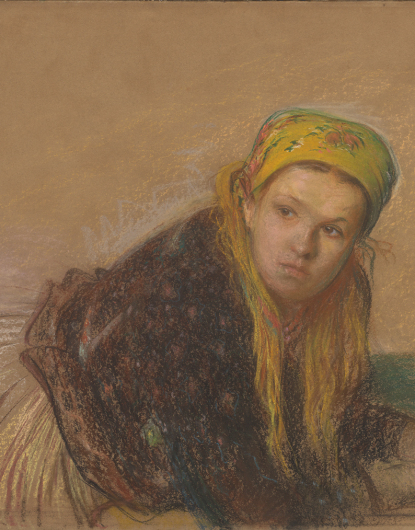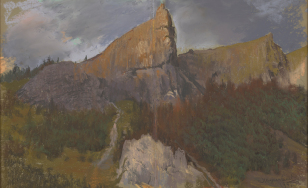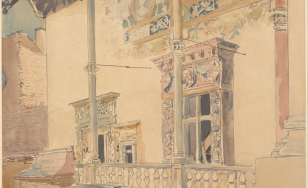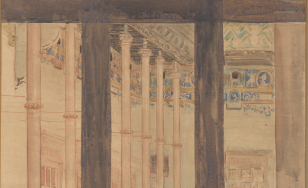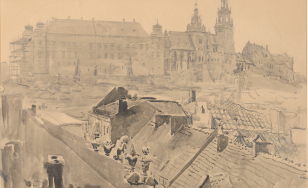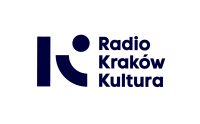Wyczółkowski Rediscovered
In December 2021, the pastel Tatra Highlander Girl / Country Girl in a Yellow Kerchief by Leon Wyczółkowski (1852–1936), which had disappeared during World War II, returned to Wawel Royal Castle.
The work appeared on the art market in Poland in December 2020. Recognized by staff members of the Department of Cultural Heritage Abroad and Wartime Losses of the Ministry of Culture and National Heritage as the lost Wyczółkowski, it was duly purchased. This important event inspired the present exhibition focusing on three themes: wartime losses and the search process; Leon Piniński, his collection, and his generosity in support of Wawel Castle; and finally Wawel Hill and its architecture, an abiding motif in Wyczółkowski’s work. The outstanding painter, draughtsman, and printmaker often depicted the historic architecture of Krakow, a city with which he was connected for many years.
The work appeared on the art market in Poland in December 2020. Recognized by staff members of the Department of Cultural Heritage Abroad and Wartime Losses of the Ministry of Culture and National Heritage as the lost Wyczółkowski, it was duly purchased. This important event inspired the present exhibition focusing on three themes: wartime losses and the search process; Leon Piniński, his collection, and his generosity in support of Wawel Castle; and finally Wawel Hill and its architecture, an abiding motif in Wyczółkowski’s work. The outstanding painter, draughtsman, and printmaker often depicted the historic architecture of Krakow, a city with which he was connected for many years.

Pride of place in the exhibition is given to the recovered pastel, which was executed in 1900 and acquired by Piniński shortly thereafter. The lyrical image of a pensive girl in folk costume speaks not only to the artist’s interest in the countryside and its inhabitants, but also to his talent as a portraitist. The model’s relaxed pose and the patterned yellow kerchief tied in back—the main colorful accent in the picture—capture the viewer’s attention.
The pastel comes from the collection of Leon Piniński (1857–1938). Closely tied to Lwów (now Lviv), Piniński was a lawyer, politician, and professor, later becoming rector of the University of Lwów, as well as an art connoisseur and collector.
The pastel comes from the collection of Leon Piniński (1857–1938). Closely tied to Lwów (now Lviv), Piniński was a lawyer, politician, and professor, later becoming rector of the University of Lwów, as well as an art connoisseur and collector.

Wyczółkowski painted the portrait (1899) on view in the exhibition when Piniński was viceroy of Galicia (1898–1903). Wawel was important to Piniński, who first became involved in recovering the castle from the Austrian army and later with its furnishing. As a member of the Wawel advisory committees, he often voiced his reservations concerning the restoration work being carried out by Adolf Szyszko-Bohusz. He spoke out about Xawery Dunikowski’s series Wawel Heads and the Wawel painted ceilings, among other things. When he wanted to donate part of his collection to the State Art Collection at Wawel, he established the Count Leon Piniński Wawel Foundation in 1931; it was accredited by the voivode of Lwów in 1935. He owned the pastel Tatra Mountain Landscape, one of the many works Wyczółkowski executed during his stays in Zakopane. Among them were his symbolist inspired by the legends and motifs of the Tatras.
The views of Wawel in the exhibition recall Piniński’s association with the former royal residence. Wyczółkowski eagerly painted Wawel Castle, depicting Wawel Hill from various viewpoints, the Arcaded Courtyard, and – exceptionally – the castle interiors. Looking at the light-filled pictures of the Arcaded Courtyard (1916–1918), one must remember that photographic accuracy was not the artist’s intent, but rather a composition of high artistic value. To achieve color harmony he completed the frieze, which in reality has not survived in full.
Wyczółkowski sometimes worked on the same subject in different media, such as, for example, the bay window in the castle’s west wing and the striking view of the sunlit Arcaded Courtyard seen from the shadows of the vaulted Berrecci Gate. There are lithographic versions of both works. In turn, in the View of the Arcaded Courtyard from a Castle Window (1918) the artist employed a similar device to the autolithograph The Sigismund Chapel from the portfolio Wawel I.II (1911/1912) – showing a wing of the castle seen through the window grid, which marks out the vertical and horizontal lines of the composition. The eyecatching picture Wawel Hill from the North is seen from the roof of a house on the corner of Grodzka and Senacka streets.
Rounding out the exhibition are two works linked with the cathedral, a subject that constantly weaves through Wyczółkowski’s oeuvre. The first is the pastel Rationale and the So-called Casket of Queen Jadwiga, an artist’s replica of a work from the series The Wawel Treasury of 1907, which is preserved in the National Museum in Warsaw. The second is a watercolor of the tomb of Queen Anna Jagiellon in the Sigismund Chapel.
Wyczółkowski sometimes worked on the same subject in different media, such as, for example, the bay window in the castle’s west wing and the striking view of the sunlit Arcaded Courtyard seen from the shadows of the vaulted Berrecci Gate. There are lithographic versions of both works. In turn, in the View of the Arcaded Courtyard from a Castle Window (1918) the artist employed a similar device to the autolithograph The Sigismund Chapel from the portfolio Wawel I.II (1911/1912) – showing a wing of the castle seen through the window grid, which marks out the vertical and horizontal lines of the composition. The eyecatching picture Wawel Hill from the North is seen from the roof of a house on the corner of Grodzka and Senacka streets.
Rounding out the exhibition are two works linked with the cathedral, a subject that constantly weaves through Wyczółkowski’s oeuvre. The first is the pastel Rationale and the So-called Casket of Queen Jadwiga, an artist’s replica of a work from the series The Wawel Treasury of 1907, which is preserved in the National Museum in Warsaw. The second is a watercolor of the tomb of Queen Anna Jagiellon in the Sigismund Chapel.
Exhibition location

Заходи
Запрошуємо вас скористатися просвітницькою програмою, яка супроводжує виставку Вичулковський віднайдений (Wyczółkowski odnaleziony). Тематично різноманітні заходи наблизять роботи, представлені на виставці, і стануть основою для поглиблення знань щодо життя і творчості митця. Для молоді та дорослих передбачені зустрічі, які, зокрема, піднімають питання збору та захисту пам’яток, а також процесу відшкодування воєнних втрат. Окремі заходи будуть доповнені аудіосупроводом, перекладом на польську мову жестів та українську мову. У теплій, приємній, а, насамперед, творчій атмосфері будуть відбуватися просвітницькі зустрічі для сімей з дітьми. Вони сприятимуть інтеграції місцевої спільноти з гостями з України, які перебувають у Кракові.
посилання на сторінку освітнього циклу
посилання на сторінку освітнього циклу
